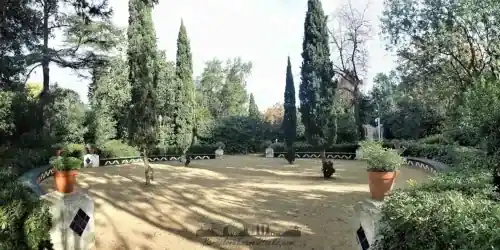Warning: Undefined array key "HTTP_ACCEPT_LANGUAGE" in /home/barcjkkl/public_html/App/Config/MySQL/language.php on line 32
Deprecated: explode(): Passing null to parameter #2 ($string) of type string is deprecated in /home/barcjkkl/public_html/App/Config/MySQL/language.php on line 36
Montjuïc Castle Bastioned Fortress Visitor Info
Military Museum & Fortress. Former prison & execution site from the Civil War. Spanish Army Barracks till 2007. City Viewpoint
About Montjuïc Castle Visitor Info
Montjuïc castle or Castell de Montjuïc is at the highest point at the top of Montjuïc hill at a height of 173 metres above sea level. The castle provides stunning 360 degree panoramic views of the Port of Barcelona and of the city where you can see important landmarks such as Sagrada Familia.
From the Montjuïc Cable Car upper station you will see multiple artilery pieces ranged at barcelona city and port as you aproach the drawbridge access road. Inside the castle are more artillery pieces. The Artilery is from a period of history starting with muzzle loaded cannons to breach loaded shell firing rail guns.
Montjuïc castle History
The castle in Montjuïc started out as a simple watch tower that was used for optical semaphore and flag based communication. The watch tower could communicate with Barcelona city and other points such as Mirador Del Semafor in El Prat de Llobregat as well as the Sant Pere de Martir summit in Collserola.
The watch tower was not militarised until the Reapers War in 1640. In 1652, the fortress, which stands on the site of a watchtower, came under royal ownership and was one of the key defence points in the War of the Spanish Succession, between 1705 and 1714.
In the 18th century, the military engineer, Juan Martín Cermeño, was commissioned to restore montjuic fortress which had been badly damaged during the war of sucession. The version of montjuic castle we see today dates from this time.
Juan Martín Cermeño also assisted with the construction of the citadel fortress, now the parc Cuitadella area of Barcelona and bagan the construction of the Sant Ferran Fortress in Figueres.
Montjuïc castle exists more to control the population of Barcelona than to protect the port. It has launched shelling on barcelona city on a number of occasions and it has also been used as a prison.
After the Spanish Civil War (1936 to 1939), Montjuïc castle was barracked by francoist soldiers and was used as a military prision. On 15th October 1940, the deposed president of the Catalan government, Lluís Companys i Jover, was executed by firing squad at the castle.
Montjuïc castle was in use as a military prison until 1960 when ownership was transfered to Barcelona city. The castle then became an army base for the spanish Army and Franco opened a weapons museum inside and allowed limited public access to the museum.
In 2007 The Spanish military stopped using it as a base and ownership was transferred to the Catalan Government. At this time the castle was in a very dilapidated state.
The Catalan Government are restoring and opening more parts of the castle to the public with most of the enclosure being accessible today.
When visiting the fortress you will note that it is surrounded by pine tree's on the city facing side. At the time of this being an active fortress, the trees did not exist, but were sloping grass hills to make ascent to the moat for attack difficult. Also the fortress needed clear sight lines for the cannons.
Image Gallery for Image Gallery For Montjuïc Castle Visitor Info
Click on any of the 17 images to open full screen gallery player
Visiting Montjuïc Castle Visitor Info
TIP: Inside the castle behind the main keep, there is a citrus grove with lemon and orange trees. Here you will find a fountain that dispenses free drinking water.
Once finished inside the Castle there is a nice circular walking route round the perimeter of castell de Montjuïc with a distance of 1.5 km. This route offers spectacular views of the port of Barcelona on one side and the city on the other side.
- Montjuic Castle is Open Monday to Sunday inclusive
- From 1st March till November 1st: 10:00h till 20:00h.
- From 2nd November till 28th february: 10:00h till 18:00h.
- CLOSED: 25th December & January 1st
- Castle + Botanical Garden - Adult: 10 € / reduced: 7 €
- Castle + Museum of Ethnology and World Cultures - Adult: 10 € / reduced: 7 €
- 13:00h English
- 15:30h Spanish
- 16:30h Catalan
Montjuïc castle Opening Hours
Montjuïc castle Combined Ticket options
Montjuïc castle Guided Tours
Weekends and public Holidays - Adult: 13 € / reduced: 10 € / free access days: 4 €
Where to eat at Montjuïc castle
inside the main parade square of the castle there is a small restaurant, La cafeteria del Castell de Montjuïc, selling hot and cold food, bottled water, cola, snacks at tourist prices.
If you walk round the castle via the outside path, at the back of the castle you will find a bar called La Caseta in the middle of the pine forest. This bar has fantastic views of the port and also has live music and a fantastic vibe. La Caseta is open from mid day till midnight on the weekends. If you go here order the local beer made in Barcelona called Moritz.
What to take with you for What to take with you for Montjuïc Castle Visitor Info
Visitors are not allowed to move around the Castle on any wheeled-mobility system, such as bicycles (which they are allowed to park in a space arranged for that purpose), skateboards, skates or any other electric transport device (which must be left inside the lockers), except where necessary for people with reduced mobility.
There is a lift from the ground floor to the first floor for so pushchairs and those with reduced mobility can have access.
the roof terrace viewpoint is only accessible via stars.
Montjuïc Castle Visitor Info Summary of Prices Summary of Prices
Getting to Montjuïc Castle Visitor Info
Address: Caraterra de Montjuïc 66, Barcelona, 08038
There are three ways to get to Montjuïc Castle:
- Get the TMB Funicular de Montjuïc followed by the Montjuïc teleferico Cable car.
- Walk up from Plaza Espana through Montjuïc gardens following my Wikiloc route.
- Get the TMB 150 Bus from plaza Catalunya. The bus stop is at the base of the Venetian towers. The route takes about 20 minutes to get to the castle. Use a T-casual travel card or hola BCN card. See the Montjuïc 150 bus route map for more information.
Use a T-Casual or Hola-Barcelona travel card for the Metro and Montjuïc Funicular. The Montjuïc Cable car ticket has to be bought seperatly.
Map for Montjuïc Castle Visitor Info
Weather for Montjuïc Castle Visitor Info
Where to stay overnight near Montjuïc Castle Visitor Info
5 Nearby Attractions to Montjuïc Castle Visitor Info
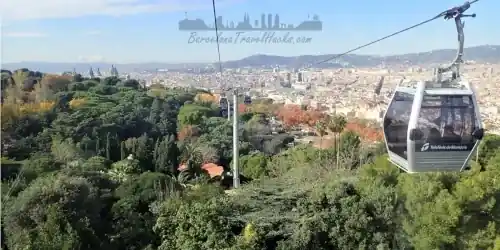
Montjuïc TMB Funicular & Cable Car to Montjuïc Castle
Teleferic de Montjuïc gondola cable car to Montjuïc Castle & Funicular deMontjuïc. Tickets and info for getting to Montjuïc castle
Read more >
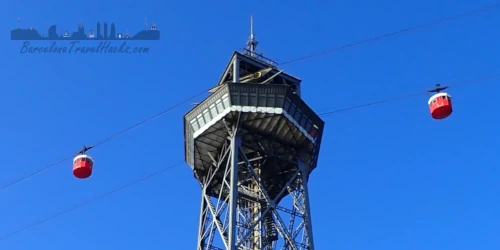
Barcelona Port Cable Car Tickets & info Teleferic del Port
Barcelona Transbordador Aeri del Port cable car 1.3Km over Port Vell Marina from Montjuic to Barceloneta. Tickets & Tips
Read more >
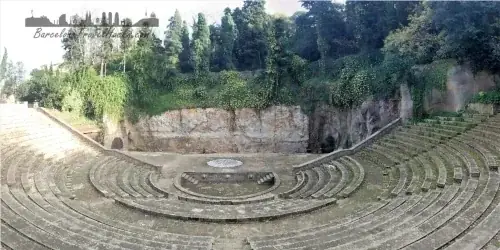
Greek open air theatre and Rose Garden in Montjuïc
Former quarry converted to open air theatre for 1929 International Exhibition. Plays and dance by Festival Grec de Barcelona in summer. Space for yoga classes
Read more >
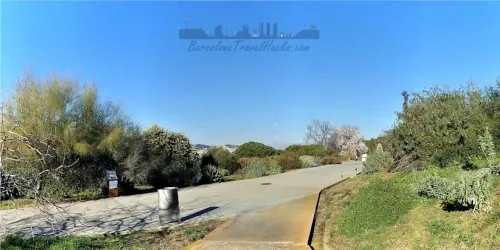
Barcelona Botanical Gardens - Barcelona Jardí Botànic
Visit the botanical garden of Barcelona at Montjuïc hill to discover the Bonsai collection & Flowering plants and trees in spring
Read more >
